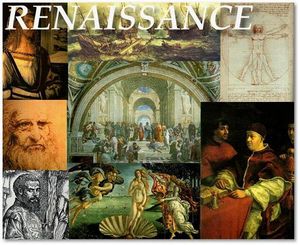Turning Point - Renaissance
The Renaissance
The Renaissance was a time of creativity and change in Europe. It was a rebirth of cultural and intellectual pursuits after the stagnation of the Middle Ages. The Renaissance was caused by the new trade routes between Europe, the Middle East, and Asia during the Crusades. The Byzantine Empire stored all of the knowledge of the Roman Empire and the knowledge from Ancient Greece. Once the crusaders traveled to the Holy Land they passed through the Byzantine Empire and brought back the knowledge to Europe. The Renaissance produced a golden age with many achievements in art, literature, and science, but most importantly, it produced a new concept of how people thought of themselves, each other, and the world around them. The Renaissance was centered in Italy during the 1300s, before spreading throughout Europe in the 1500 and 1600s.
Humanism
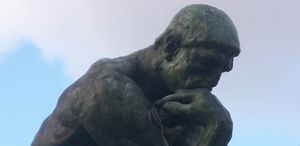
Humanism was an intellectual movement where people began to focus on life in the present, which was in contrast to the Middle Ages' focus on the after life. Humanism stressed the importance of education, with the study of ancient Greek and Roman texts becoming the learning standard. Humanism stressed the importance of the individual. This movement was the driving force of the Renaissance and is reflected in the period's artistic, literary, and scientific achievements.
Art & Architecture
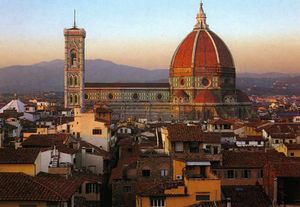
Renaissance artists and architects produced some of the finest works in all the world. While religious art was still very prominent, new styles were developed. Humanist ideas, and the concept of realism, was reflected in many art forms. Artists such as Leonardo Da Vinci studied anatomy, while others used live models to better catch the human form. Artists also learned the rules of perspective allowing them to give their works a 3 dimensional appearance.
Architects revived many ancient Greek and Roman styles, such as the use of columns, domes, and arches.
Artists
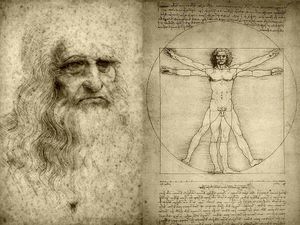
Michelangelo
Michelangelo was a sculptor, painter, poet, engineer, and architect. Famous works include the mural on the ceiling of the Sistine Chapel, and the sculpture of the biblical character David.
Leonardo Da Vinci
Leonardo Da Vinci was a true Renaissance man interested in a variety of subjects. He was a painter, sculptor, engineer, and inventor. His famous works include paintings Mona Lisa and The Last Supper. Also left a variety of sketches showing flying machines and underwater boats centuries before the invention of planes and submarines.
Literature
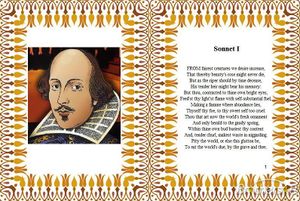
Humanist ideas are reflected in works of Renaissance literature. The most famous writer of the time, William Shakespeare, wrote 37 plays between 1590 and 1613. His plays reflect the ideas of individualism and the unconquerable human spirit, and most of them are still performed today. Other important Renaissance authors include Dante, who wrote The Divine Comedy, and Miguel de Cervantes who wrote the comedic tale Don Quixote.
Besides works of fiction, writings on political philosophy reappeared during this time period. the most well know political philosopher of the Renaissance was Niccolo Machiavelli, whose book The Prince, reads as a "how to" guide for successful rule.
.
Political & Social Humanists
Petrarch (1304-1374)
Petrarch was the Father of Humanism, a Florentine who spent his youth in Tuscany and lived in Milan and Venice. He was a collector of old manuscripts and through his efforts the speeches of Cicero and the poems of Homer and Virgil became known to Western Europe. Petrarch's works also led to the rise of people known as Civic Humanists, or those individuals who were civic-minded and looked to the governments of the ancient worlds for inspiration. Petrarch also wrote sonnets in Italian. Many of these sonnets expressed his love for the beautiful Laura. His sonnets greatly influenced other writers of the time.
Erasmus (c.1466–1536)
All his work displays his huge learning and intellectual brilliance, but also his humanity and wit. Many of his early works attacked corruption and superstition in the church and his famous satire 'The Praise of Folie' (1509), dedicated to his English friend Thomas More, advocated a return to a more simple Christianity. He translated and edited many classical and early Christian works and also published a critical edition of the Greek text of the New Testament which drew on newly available sources and was immensely influential. It symbolised the humanist desire to return to the sources of the Christian tradition.
Castiglione (1478-1529)
Castiglione wrote one of the most widely read books, The Courtier, which set forth the criteria on how to be the ideal Renaissance man. Castiglione's ideal courtier (person of the royal court) was a well-educated, mannered aristocrat who was a master in many fields from poetry to music to sports.
Machiavelli (1459-1527)
Besides works of fiction, writings on political philosophy reappeared during this time period. the most well know political philosopher of the Renaissance was Niccolo Machiavelli, whose book The Prince, reads as a "how to" guide for successful rule.
Machiavelli wrote the book "The Prince" which emphasized control of the people by a ruler to establish a society where people would be best served by the ruler. It is questioned whether the book was a satire or a rule book. Most historians now believe it to be satire. Some of his most famous principles are below.
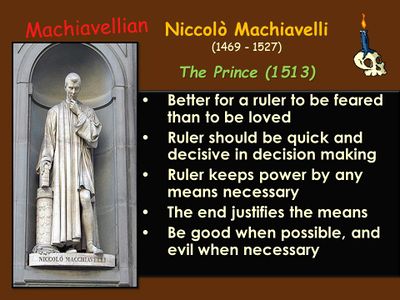
Sir Thomas More (1478–1535)
Sir Thomas More published his most important work 'Utopia' - a description of an imaginary republic ruled by reason and intended to contrast with the strife-ridden reality of contemporary European politics. More remained a passionate defender of Catholic original teachings - writing pamphlets against heresy (going against the church), banning unorthodox (non-traditional) books, and even taking responsibility when chancellor for the interrogation of heretics (people accused of going against the church).
Technology
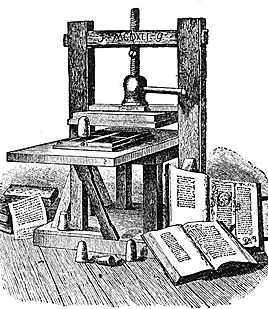
The most important technological innovation of the time was the printing press. The technology to make this possible was introduced from China in the 1300s. By the 1400s, movable type was being used in Europe as Johann Gutenberg began printing the Bible in everyday language. Soon millions of books were in circulation. This invention led to a higher literacy rate among people, and helped with the spreading of Renaissance ideas.
